SDR / SDN - how the new architecture is implemented in a real cellular network
Cellular Communications Network is a very conservative structure due to its high cost and long construction time. Changes in communication standards occur regularly, but the transition to a new standard (for example, 3G after 2G) requires new investments and replacement of equipment, which often has not yet worked out. Now to launch a new generation network, everything becomes easier thanks to the SDR and SDN approaches.
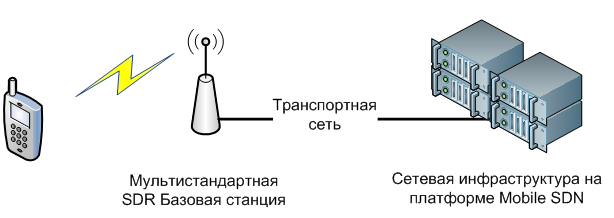
SDR (Software-Defined Radio) - software-defined radio subsystem;
SDN (Software-Defined Networking) - software-configured network building.
')
Simplifying, this is somewhat similar to the virtualization of iron: the change in functionality does not occur by replacing the material part, but by changing its program part. If you read Lem, then a crude analogy is the rebuilding of its clever structures, where identical elements made up a complex pattern. The role of each element was not determined by the design, but by its position in the structure and data from other elements. Only in our case are the program blocks, and not the elementary mechanisms, as integral parts.
I will tell how these approaches find application in a real network.
About both approaches have repeatedly written on Habré. I will tell you what features imposes on the implementation of SDR and SDN a network of a large operator, where you want to keep all the functionality inherited from the already working mobile networks.
First, a little history. Initially (as is often the case), the SDR concept was born in the depths of military departments and was intended to quickly replace obsolete radio communications protocols. Supported protocols and ranges were implemented on analog equipment, and any change required a complete physical replacement of the entire complex. The transition to digital-to-analog conversion of the radio signal has opened up the possibility of transition to new protocols and standards by simply changing the software in the digital unit.
For many years, this approach was difficult to implement in mobile networks of operators, because it made very high demands on the performance of the digital unit responsible for the conversion. But Moore's law proved its fairness, and the power of computing systems reached values sufficient to process the algorithms embedded in mobile networks of GSM / UMTS / LTE standards. This seems to allow us to switch to pure SDR systems and get compact and productive base stations. However, a second problem arose here related to the spectrum used and the required output power for mobile networks of different standards.
For example, now in Russia every operator of the Big Three has mobile networks in the following ranges:
Closing the entire frequency spectrum with one transmitter is a technical problem to be solved, but the equipment will be completely unsuitable in terms of mass-dimensional characteristics for use in an existing network. Given this limitation, the standard solution for the transition to the SDR architecture is as follows: several radio modules are connected to a common processor unit, each of which provides for the creation of EM radiation in a certain frequency range.
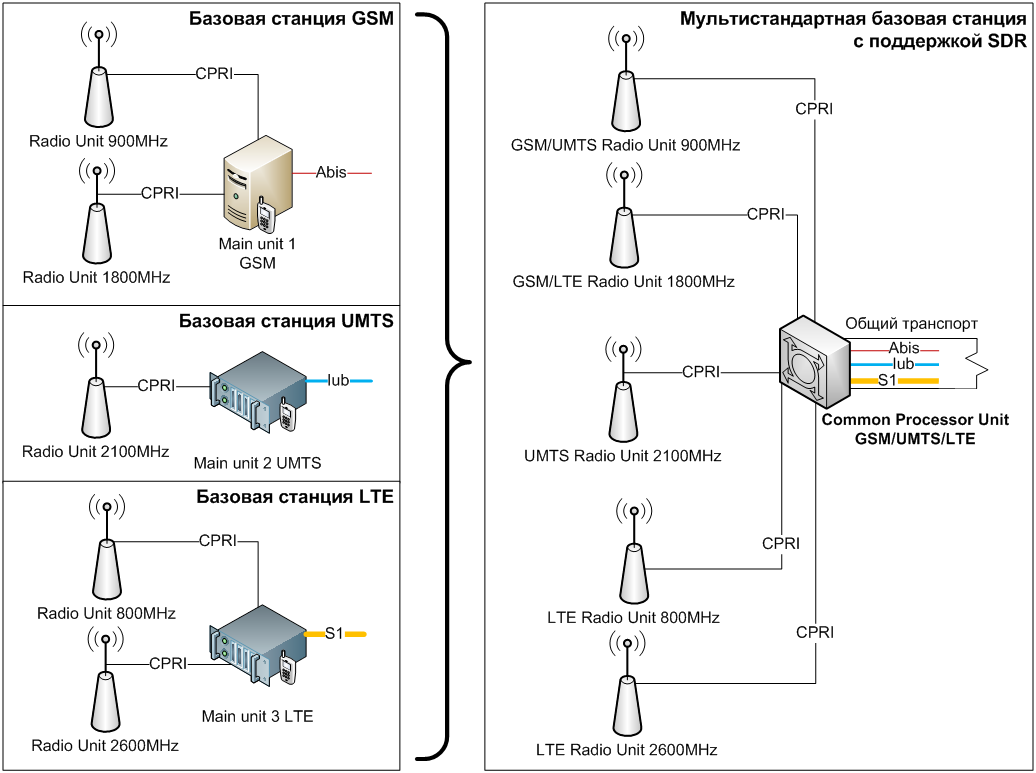
Evolution from dedicated processor units for each standard, to virtualization of all standards in a single processor unit
Which communication standard will be created in this case is determined by the processor unit and the operator's strategy for refarming some standards to others. The interface from the processor unit to the radio transmitter is also standardized, and all manufacturers offer their implementation options for the CPRI protocol - the Common Public Radio Interface. The latest implementations of the CPRI protocol are also supported by manufacturers of transport network equipment, for example, radio relay lines, which makes it possible to connect radio transmitters at considerable distances from the processor unit.
This embodiment of the SDR concept significantly reduces the number of required processor units and at the same time provides the aggregation of traffic from all standards of mobile networks into one transport network.
An example of the implementation of the concept of SDR on the equipment of base stations of a mobile network:



There were: 3 base stations for a tri-standard network (GSM / UMTS / LTE)
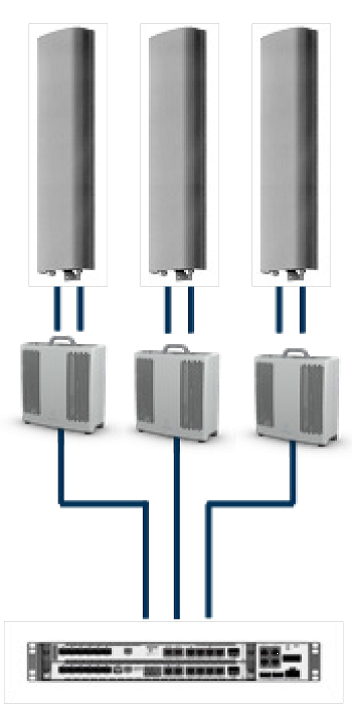
Now: separation of standards only at the level of transmitters and antennas with a common processor unit
Now we will try to present the most simplified operator's network architecture for receiving traffic from the GSM / UMTS / LTE multi-standard radio network. According to 3GPP recommendations and, accordingly, proposals from leading equipment manufacturers, the most simplified R8 release network architecture is as follows:
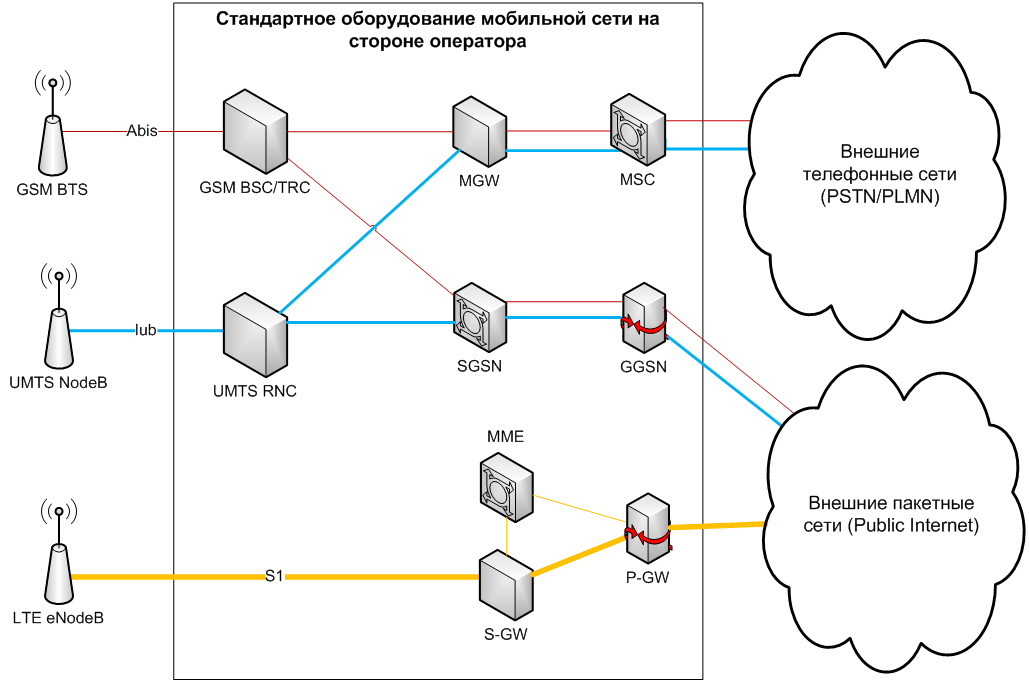
In addition, each node in the box “Standard equipment of the mobile network on the operator’s side” is a whole rack of equipment (and often not one) with specific interfaces, cards, original sabracks, etc. Suppliers of different nodes are different manufacturers, equipment belongs to different generations or even epochs of network development. The operation of such a “zoo” is a difficult task, requiring qualified engineers, and, having experience in operating various equipment, from various manufacturers. Here is the time to recall the concept of SDN, which seems to be specifically designed to optimize such an architecture.
Now, SDN is an abbreviation of software-defined transport networks. However, in mobile networks, this concept is combined with the algorithms of “virtualization” - Mobile Virtualization - and from them comes the new mobile network construction architecture - Mobile SDN. The basic approaches used in designing mobile SDN networks are the same as for transport networks:
The new architecture actually means the replacement of all types of diverse mobile network equipment (BSC / RNC / MSC / MSS / SGSN / GGSN / MME, etc.) with a common HW platform on which all their functions are virtualized. If you build a network using SDR and SDN approaches, you can get the following picture from the point of view of carrier equipment:
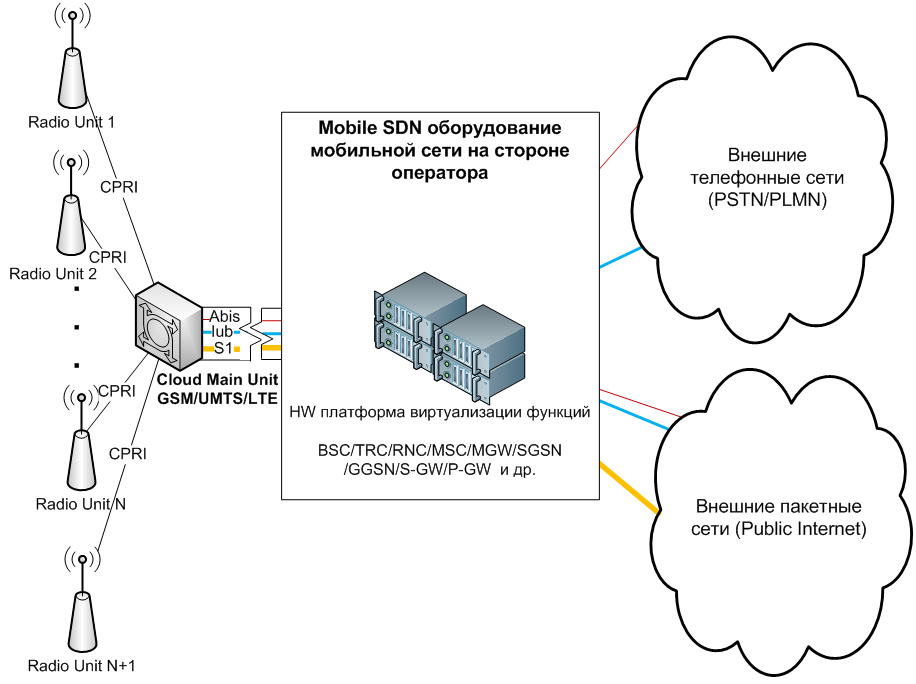
The mobile network built on the principles of Mobile SDN, supplemented by a radio network built on the principles of SDR, allows you to create modern mobile networks on which you can easily switch from standard to standard (GSM-UMTS-LTE-LTE Adv-....), providing the latest services in the shortest possible time.
This means that soon we will not have to install a new equipment rack and puzzle over its integration with a live network to implement the new functionality introduced in the new standard. It will be enough to update the software on our platform with virtual machines, and the new functionality is open for use.
The concepts described in the article are now at different stages of industrial implementation. SDR can be called an actual fact: all the latest models of base stations from leading manufacturers are performed according to this scheme, allowing you to use a common processor unit and ensure the operation of radio transmitters of a given range simultaneously in several standards. All Beeline mobile networks under construction in recent years use this approach in terms of radio access equipment.
The concept of SDN in mobile networks (as, indeed, in transport) is only gaining momentum. Leading equipment manufacturers are starting to experiment with the virtualization of various functions based on productive servers from third companies or using their own developments.
For example, the new type of controller from the NSN company mentioned in the recent Test Zone review is a pure SDN platform. However, for the time being it is intended to virtualize only the network elements to which the base stations are connected - BSC / TRC / RNC, and cannot perform all the functions at the same time (each logical function requires a dedicated HW module), but a single hardware platform is a significant step operator network optimization side.
It was - the standard RNC platform (stand alone):

It became - SDN platform RNC (8 Rack Unit):
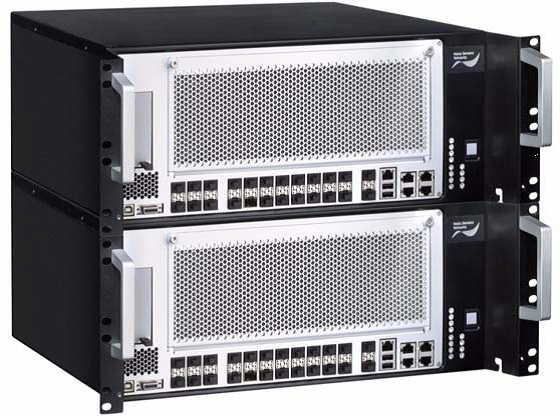
As a second example, I will cite a Cisco solution recently tested in the Test Zone - the Cisco Unified Computing System, Cisco Unified Computing System. In fact, it is a Blade Server, where you can run any application for any operating system using virtual machines, in particular, any application used on Cisco equipment (Cisco IOS, StarOS, etc.). In our laboratory, we tested network solutions: "Cisco HomeNodeB Gateway", "Cisco Wi-Fi Access Gateway" with simultaneous emulation on the same server of a large number of necessary network elements - SecGW, DHCP Server, AAA, SGSN, PCEF, etc.
In the laboratory, the functionality and viability of the SDN concept has already been confirmed, now manufacturers are working to ensure the required level of performance to handle the huge amounts of traffic generated in modern mobile networks.

SDR (Software-Defined Radio) - software-defined radio subsystem;
SDN (Software-Defined Networking) - software-configured network building.
')
Simplifying, this is somewhat similar to the virtualization of iron: the change in functionality does not occur by replacing the material part, but by changing its program part. If you read Lem, then a crude analogy is the rebuilding of its clever structures, where identical elements made up a complex pattern. The role of each element was not determined by the design, but by its position in the structure and data from other elements. Only in our case are the program blocks, and not the elementary mechanisms, as integral parts.
I will tell how these approaches find application in a real network.
About both approaches have repeatedly written on Habré. I will tell you what features imposes on the implementation of SDR and SDN a network of a large operator, where you want to keep all the functionality inherited from the already working mobile networks.
Prehistory
First, a little history. Initially (as is often the case), the SDR concept was born in the depths of military departments and was intended to quickly replace obsolete radio communications protocols. Supported protocols and ranges were implemented on analog equipment, and any change required a complete physical replacement of the entire complex. The transition to digital-to-analog conversion of the radio signal has opened up the possibility of transition to new protocols and standards by simply changing the software in the digital unit.
For many years, this approach was difficult to implement in mobile networks of operators, because it made very high demands on the performance of the digital unit responsible for the conversion. But Moore's law proved its fairness, and the power of computing systems reached values sufficient to process the algorithms embedded in mobile networks of GSM / UMTS / LTE standards. This seems to allow us to switch to pure SDR systems and get compact and productive base stations. However, a second problem arose here related to the spectrum used and the required output power for mobile networks of different standards.
For example, now in Russia every operator of the Big Three has mobile networks in the following ranges:
3 GPP Band | Communication standard | UL, MHz range | DL range , MHz |
Band 20 | LTE 800 | ||
Band 8 | GSM 900 -> UMTS 900 | 880 - 915 | 925 - 960 |
Band 3 | GSM 1800 -> LTE 1800 | 1710 - 1785 | 1805 - 1880 |
Band 1 | UMTS 2100 | 1920 - 1980 | 2110 - 2170 |
Band 7 | LTE 2600 | 2500 - 2570 | 2620 - 2690 |
Closing the entire frequency spectrum with one transmitter is a technical problem to be solved, but the equipment will be completely unsuitable in terms of mass-dimensional characteristics for use in an existing network. Given this limitation, the standard solution for the transition to the SDR architecture is as follows: several radio modules are connected to a common processor unit, each of which provides for the creation of EM radiation in a certain frequency range.

Evolution from dedicated processor units for each standard, to virtualization of all standards in a single processor unit
Which communication standard will be created in this case is determined by the processor unit and the operator's strategy for refarming some standards to others. The interface from the processor unit to the radio transmitter is also standardized, and all manufacturers offer their implementation options for the CPRI protocol - the Common Public Radio Interface. The latest implementations of the CPRI protocol are also supported by manufacturers of transport network equipment, for example, radio relay lines, which makes it possible to connect radio transmitters at considerable distances from the processor unit.
This embodiment of the SDR concept significantly reduces the number of required processor units and at the same time provides the aggregation of traffic from all standards of mobile networks into one transport network.
Today
An example of the implementation of the concept of SDR on the equipment of base stations of a mobile network:



There were: 3 base stations for a tri-standard network (GSM / UMTS / LTE)

Now: separation of standards only at the level of transmitters and antennas with a common processor unit
Now we will try to present the most simplified operator's network architecture for receiving traffic from the GSM / UMTS / LTE multi-standard radio network. According to 3GPP recommendations and, accordingly, proposals from leading equipment manufacturers, the most simplified R8 release network architecture is as follows:

In addition, each node in the box “Standard equipment of the mobile network on the operator’s side” is a whole rack of equipment (and often not one) with specific interfaces, cards, original sabracks, etc. Suppliers of different nodes are different manufacturers, equipment belongs to different generations or even epochs of network development. The operation of such a “zoo” is a difficult task, requiring qualified engineers, and, having experience in operating various equipment, from various manufacturers. Here is the time to recall the concept of SDN, which seems to be specifically designed to optimize such an architecture.
Now, SDN is an abbreviation of software-defined transport networks. However, in mobile networks, this concept is combined with the algorithms of “virtualization” - Mobile Virtualization - and from them comes the new mobile network construction architecture - Mobile SDN. The basic approaches used in designing mobile SDN networks are the same as for transport networks:
- Separation of the signaling level (traffic control protocols, signaling protocols of the transport layer, etc.) and user traffic;
- Virtualization of the necessary processes on powerful server platforms that provide the necessary processing power for signaling processing and interface capacity for passing user traffic.
The new architecture actually means the replacement of all types of diverse mobile network equipment (BSC / RNC / MSC / MSS / SGSN / GGSN / MME, etc.) with a common HW platform on which all their functions are virtualized. If you build a network using SDR and SDN approaches, you can get the following picture from the point of view of carrier equipment:

The mobile network built on the principles of Mobile SDN, supplemented by a radio network built on the principles of SDR, allows you to create modern mobile networks on which you can easily switch from standard to standard (GSM-UMTS-LTE-LTE Adv-....), providing the latest services in the shortest possible time.
This means that soon we will not have to install a new equipment rack and puzzle over its integration with a live network to implement the new functionality introduced in the new standard. It will be enough to update the software on our platform with virtual machines, and the new functionality is open for use.
The concepts described in the article are now at different stages of industrial implementation. SDR can be called an actual fact: all the latest models of base stations from leading manufacturers are performed according to this scheme, allowing you to use a common processor unit and ensure the operation of radio transmitters of a given range simultaneously in several standards. All Beeline mobile networks under construction in recent years use this approach in terms of radio access equipment.
The concept of SDN in mobile networks (as, indeed, in transport) is only gaining momentum. Leading equipment manufacturers are starting to experiment with the virtualization of various functions based on productive servers from third companies or using their own developments.
For example, the new type of controller from the NSN company mentioned in the recent Test Zone review is a pure SDN platform. However, for the time being it is intended to virtualize only the network elements to which the base stations are connected - BSC / TRC / RNC, and cannot perform all the functions at the same time (each logical function requires a dedicated HW module), but a single hardware platform is a significant step operator network optimization side.
It was - the standard RNC platform (stand alone):

It became - SDN platform RNC (8 Rack Unit):

As a second example, I will cite a Cisco solution recently tested in the Test Zone - the Cisco Unified Computing System, Cisco Unified Computing System. In fact, it is a Blade Server, where you can run any application for any operating system using virtual machines, in particular, any application used on Cisco equipment (Cisco IOS, StarOS, etc.). In our laboratory, we tested network solutions: "Cisco HomeNodeB Gateway", "Cisco Wi-Fi Access Gateway" with simultaneous emulation on the same server of a large number of necessary network elements - SecGW, DHCP Server, AAA, SGSN, PCEF, etc.
In the laboratory, the functionality and viability of the SDN concept has already been confirmed, now manufacturers are working to ensure the required level of performance to handle the huge amounts of traffic generated in modern mobile networks.
Source: https://habr.com/ru/post/237221/
All Articles